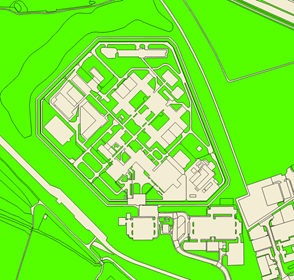 OS Mastermap Topography layer showing HMP Holme House. ©2019 Ordnance Survey OS Mastermap Topography layer showing HMP Holme House. ©2019 Ordnance Survey One of the things about being a methods scholar is that you can flit about between subjects. For a job interview a couple of years ago I made a list of the different disciplinary backgrounds of people that I’d collaborated with. This included those working in hydrology, law, design, planning, sociology, psychology, social work, heritage studies, poetry, photography and performance art. It’s quite fun to learn about other people’s approaches to different topics and think about how your own expertise can help bring something useful to the discussion. Carceral geographer Dom Moran and I have been friends and colleagues for over 17 years but had never actually written anything together until collaborating to produce a paper that has just come out in the Annals of the AAG. I’m not going to talk too much here about the specific findings of the paper here – you can have a look at the press release or the paper itself if you’re interested – instead I want to reflect on how the paper came about. Back in pre-Covid times Dom and I would occasionally go for coffee. There’d be a lot of the kind of chat you’d associate with old friends: various bits of banter, talking about her charming and mischievous daughter and, of course, gossip about work. But we’d also kick around research ideas, and back in 2018 we were both getting interested in green space, albeit for different reasons. I’d been working to develop a grant application with a bioscientist and an ecologist around physiological response to green environments. Dom, meanwhile, was generating really interesting qualitative data about the positive effects of exposure to greenspace on prisoner wellbeing. Over coffee, however, she was talking about how policymakers prefer hard numbers when seeking to change the management of prisons. We’d already been chatting about prison violence statistics, which are available as open data for UK jails and make for pretty horrendous reading. It occurred to us that if we could measure prisoners’ exposure to green space, we could perhaps see if there were any connections between this and violence. As someone who enjoys playing around with GIS, I wondered whether there were datasets available that could indicate how much greenspace exists in and around a prison – the simple presence of greenspace acting as a crude proxy for exposure. The MasterMap Topography dataset is the Ordnance Survey’s highest resolution mapping for the UK, operating at the 1:1250 scale. Building footprints, exercise yards, football pitches etc. within prisons are all carefully surveyed and mapped with a great deal of accuracy. MasterMap also tells you what type of surface you’re looking at, hence an all-weather sports pitch is labelled as artificial, where a grass verge as shown as a green ‘natural’ surface. Thus, we were able to accurately measure the amount of green space both inside and immediately outside the prison walls. Dom went off and secured some UoB ‘impact’ funds to pay for a PhD student from Archaeology (the very excellent Amy Porter) to download and analyse MasterMap data for all prisons in England and Wales to create a spreadsheet of how much green space there was in and around each of them. This spreadsheet could then be combined with the violence statistics to start to look for statistically robust relationships. Neither Dom nor I, however, have the skills to do this. Hence Dom called on an old friend and former colleague of ours, the econometric modeller Jacob Jordaan from Utrecht University. He was able to run the numbers and demonstrate that even allowing for other factors such as age and type of prison, as the amount of green space increases so you see a statistically significant decrease in levels of violence. This has then given Dom the material to lead a whole bunch of papers exploring different aspects of the dataset, of which the one in Annals is the first to come out. This is pretty cool and obviously really helpful for giving policymakers a robust analysis to inform prison design. But more than this, it illustrates how some projects really do rely on a group of people with different expertise coming together. Dom’s knowledge of prisons, my knowledge of GIS and Jacob’s knowledge of statistical modelling were all vital to this research and none of us would have been in a position to conceive and deliver the project without the others’ input. Plus, it was great fun to work on, which all the best projects are, particularly when you’re collaborating with such lovely people.
0 Comments
Leave a Reply. |
AuthorPhil Jones is a cultural geographer based at the University of Birmingham. Archives
September 2023
Categories |
Phil Jones, Geographer
The INTERMITTENTLY updated blog
Proudly powered by Weebly
 RSS Feed
RSS Feed